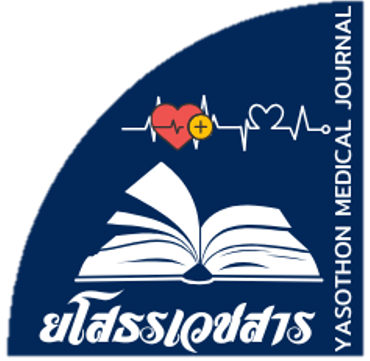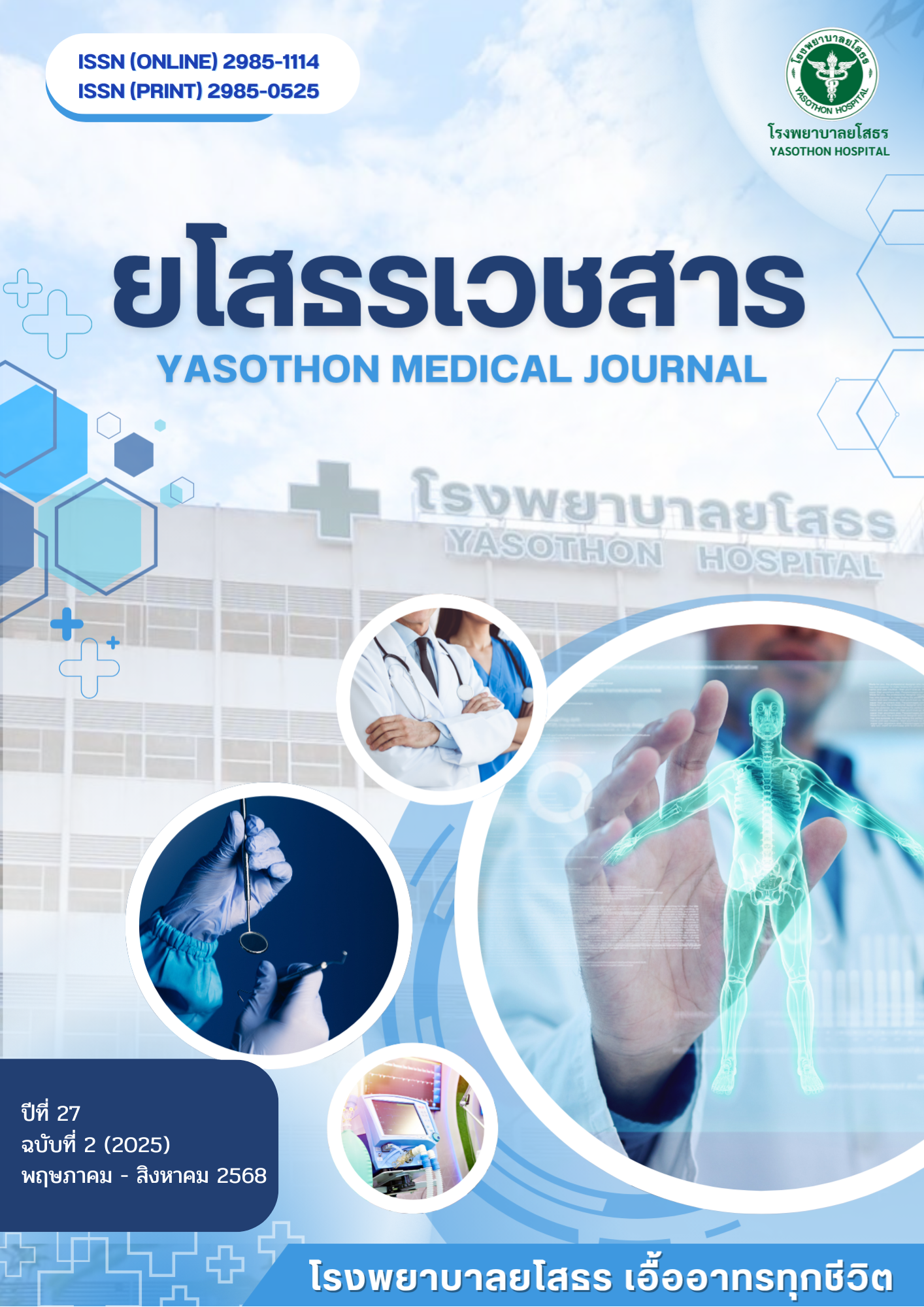ประสิทธิภาพของ Carcinoembryonic Antigen (CEA) ในการตรวจหาการกลับเป็นซ้ำของมะเร็งเต้านม ในโรงพยาบาลอำนาจเจริญ
คำสำคัญ:
มะเร็งเต้านม, การกลับเป็นซ้ำ, CEA,, Tumor Marker, การติดตามบทคัดย่อ
หลักการและเหตุผล: มะเร็งเต้านมเป็นปัญหาสาธารณสุขที่สำคัญ การติดตามการกลับเป็นซ้ำมักอาศัยการตรวจร่างกายร่วมกับสารบ่งชี้มะเร็ง โดยเฉพาะ CEA อย่างไรก็ตาม ประสิทธิภาพของ CEA ในการติดตามผู้ป่วยยังมีข้อถกเถียง
วัตถุประสงค์: เพื่อศึกษาความสัมพันธ์ระหว่างระดับ CEA ในเลือดกับการกลับเป็นซ้ำของมะเร็งเต้านม รวมถึงประเมินประสิทธิภาพของ CEA ในการทำนายการกลับเป็นซ้ำในผู้ป่วยกลุ่มต่าง ๆ
วิธีการศึกษา: การวิจัยแบบ Prospective Cohort Study ในผู้ป่วยมะเร็งเต้านม 200 ราย แบ่งเป็น 2 กลุ่ม ๆ ละ 100 ราย ได้แก่ กลุ่มติดตามด้วยการตรวจร่างกายอย่างเดียว และกลุ่มติดตามร่วมกับการตรวจ CEA ติดตามผู้ป่วยทุก 3 เดือน เป็นเวลา 5 ปี วิเคราะห์ข้อมูลด้วยสถิติเชิงพรรณนาและเชิงอนุมาน
ผลการศึกษา: พบว่าระดับ CEA ตั้งแต่ 10.0 ng/mL ขึ้นไปมีความเสี่ยงต่อการกลับเป็นซ้ำสูงกว่ากลุ่มที่มีค่า CEA น้อยกว่า 5.0 ng/mL ถึง 3.17 เท่า (95% CI 1.92-5.24) และสามารถตรวจพบการเปลี่ยนแปลงได้ก่อนการวินิจฉัยทางคลินิกเฉลี่ย 3.2 เดือน โดย CEA มีประสิทธิภาพสูงสุดในผู้ป่วย Triple Negative Breast Cancer, ผู้ป่วยระยะ 3 และผู้ป่วย Hormone Receptor Negative
สรุป: CEA เป็นสารบ่งชี้มะเร็งที่มีประสิทธิภาพในการติดตามการกลับเป็นซ้ำของมะเร็งเต้านม โดยเฉพาะในกลุ่มที่มีความเสี่ยงสูง สามารถนำไปพัฒนาเป็นแนวทางการติดตามที่เหมาะสมสำหรับผู้ป่วยแต่ละกลุ่มในบริบทของโรงพยาบาลทั่วไป
คำสำคัญ: มะเร็งเต้านม, การกลับเป็นซ้ำ, CEA, Tumor Marker, การติดตาม
เอกสารอ้างอิง
World Health Organization. Global Cancer Statistics 2024. Geneva: WHO; 2024.
International Agency for Research on Cancer (IARC). Cancer Incidence in Five Continents Vol. XII. Lyon: IARC; 2023.
สถาบันมะเร็งแห่งชาติ. สถิติโรคมะเร็งในประเทศไทย พ.ศ. 2566. กรุงเทพฯ: กรมการแพทย์; 2566.
สถาบันมะเร็งแห่งชาติ. ทะเบียนมะเร็ง ระดับโรงพยาบาล พ.ศ. 2564 [อินเทอร์เน็ต]. 2564 [เข้าถึงเมื่อ 22 กุมภาพันธ์ 2568]. เข้าถึงได้จาก: https://www.nci.go.th/th/cancer_record/download/HOSPITAL-BASED_2021.pdf
สุพินดา คูณมี. ขั้นตอนทางพยาธิวิทยา (processing in pathology). ใน: สถาบันมะเร็งแห่งชาติ, บรรณาธิการ. แนวทางการตรวจวินิจฉัยและรักษาโรคเต้มนมและมะเร็งเต้านม. กรุงเทพฯ: วิตต้าคอมพิวซิสเต็มส์; 2566. หน้า 145-53.
Rubio M. What to Know About Breast Cancer Recurrence. Breast Cancer Research Foundation [Internet]. 2023 [Cited 2025 Feb 22]. Available from: https://www.bcrf.org/about-breast-cancer/breast-cancer-recurrence/
Biomedica. Novel biomarkers in breast cancer [Internet]. 2024 [Cited 2025 Feb 22]. Available from: https://www.bmgrp.com/novel-biomarkers-in-breast-cancer/
Duffy MJ, Harbeck N, Nap M, Molina R, Nicolini A, Senkus E, et al. Clinical use of biomarkers in breast cancer: Updated guidelines from the European Group on Tumor Markers (EGTM). Eur J Cancer 2017; 75: 284-98. doi: 10.1016/j.ejca.2017.01.017. PubMed PMID: 28259011.
Anoop TM, Joseph PR, Soman S, Chacko S, Mathew M. Significance of serum carcinoembryonic antigen in metastatic breast cancer patients: A prospective study. World J Clin Oncol 2022; 13(6): 529-39. doi: 10.5306/wjco.v13.i6.529. PubMed PMID: 35949431.
Harris L, Fritsche H, Mennel R, Norton L, Ravdin P, Taube S, et al. American Society of Clinical Oncology 2007 update of recommendations for the use of tumor markers in breast cancer. J Clin Oncol 2007; 25(33): 5287-312. doi: 10.1200/JCO.2007.14.2364. PubMed PMID: 17954709.
Waks AG, Winer EP. Breast Cancer Treatment: A Review. JAMA 2019; 321(3): 288-300. doi: 10.1001/jama.2018.19323. PubMed PMID: 30667505.
งานเวชระเบียนและสถิติ. สถิติผู้ป่วยมะเร็งเต้านมที่ได้รับการวินิจฉัยและรักษา ปีงบประมาณ 2562-2567. อำนาจเจริญ: โรงพยาบาลอำนาจเจริญ; 2567.
Zhang Y, Wang J, Liu S, Li H, Yang X, Wang Y, et al. Prognostic value of preoperative serum carcinoembryonic antigen and carbohydrate antigen 15-3 levels in early breast cancer. Cancer Med 2023; 12(9): 10324-35.
Wang X, Li D, Gao Y, Li Y, Zhang L. Clinical utility of serum tumor markers in the detection of breast cancer recurrence: a retrospective cohort study. J Cancer Res Clin Oncol 2022; 148(5): 1245-54.
Lin Y, Chen Z, Wang J, Chen C, Zhang X. CEA as a biomarker in breast cancer recurrence: a comprehensive review. Front Oncol 2022; 12: 848069.
Chen S, Liu Y, Yang J, Liu Q, You H, Dong Y. Development of a prognostic index based on preoperative CEA level in patients with resectable breast cancer. Breast Care 2021; 16(5): 455-62.
Rodriguez C, Cabrera-Galeana P, Arrieta O, Carmona-Bayonas A, Arana-Arri E. Tumor markers for surveillance in patients with early-stage breast cancer: a prospective cohort study. Breast 2023; 68: 187-95.
Li J, Zhang Z, Rosenzweig M, Wang YJ, Chan DW. Tumor markers for breast cancer: A systematic review and meta-analysis of diagnostic test performance. Clin Chim Acta 2024; 548: 117380.
Kim Y, Park HS, Kim H, Lim Y, Han W, Kim T, et al. Clinical significance of serum CEA for early detection of recurrence in breast cancer patients. Breast Cancer Res Treat 2022; 194(2): 407-16.
Liu M, Jia H, Wang Y, Liu Y, Chen J. Evaluation of multiple serum tumor markers in monitoring breast cancer: a single center experience. Breast Cancer 2023; 30(1): 98-108.
Park BW, Oh JW, Kim JH, Park SH, Kim KS, Kim JH, et al. Preoperative CA 15-3 and CEA serum levels as predictor for breast cancer outcomes. Ann Oncol 2008; 19(4): 675-81. doi: 10.1093/annonc/mdm538. PubMed PMID: 18037623.
Martinez A, Marquez M, Garcia-Sanz P, Jerez Y, Sepulveda JM, Calvo I. Kinetics of CEA levels in early breast cancer: clinical utility for monitoring and prediction of recurrence. Clin Transl Oncol 2022; 24(11): 2215-23.
Pang H, Luo Y, Xiao X, Xia L, Li R. Prognostic values of elevated serum CEA for different subtypes and sites of metastasis in advanced breast cancer. Br J Cancer 2022; 126(7): 1086-93.
Chen S, Zhang F, Li Q, Liu Y, Wu X. Tumor markers in the early detection of recurrent breast cancer: comparative analysis of CEA, CA15-3, and circulating tumor DNA. BMC Cancer 2023; 23(1): 432.
Wu X, Ye Y, Bao S, Yan X, Zhu X, Jiang Y, et al. Pretreatment serum CEA as a predictor for metastatic pattern in breast cancer patients. Sci Rep 2022; 12(1): 8563.
Beauchemin N, Arabzadeh A, Ploussard G. CEA and CEACAM1 in cancer progression and metastasis. Trends Cancer 2021; 7(10): 883-94.
Min J, Kim MJ, Kim JY, Kang SS, Kim S, Jung HS, et al. Clinical value of routine serum tumor markers in breast cancer surveillance. J Breast Cancer 2020; 23(4): 346-55.
Martinez A, Sanchez-Mendez JI, Vazquez S, Rodriguez C, Garcia-Saenz JA, Dominguez F. CEA elevation in triple-negative breast cancer: Clinical implications and molecular mechanisms. Breast 2021; 58: 39-45.
Zhao X, Wang M, Li Y, Chen J, Zhang Y, Li H. Analysis of glycosylation-associated gene expression profiles in different breast cancer subtypes. Mol Med Rep 2023; 27(1): 13.
Yang B, Zhang H, Gao Y, Wang Z, Zhu H, Jiang Z. Clinical value of combined detection of serum CEA, CA15-3, CA125, and TPS in follow-up of breast cancer. Cancer Manag Res 2023; 15: 109-18.
Li X, Dai D, Chen B, Tang H, Xie X, Wei W. Clinicopathological and prognostic significance of cancer antigen 15-3 and carcinoembryonic antigen in breast cancer: A meta-analysis including 12,993 patients. Dis Markers 2018; 2018: 9863092. doi: 10.1155/2018/9863092. PubMed PMID: 29854028.
Lopez R, Martinez C, Santos A, Casado A, Fernandez-Perez C, Zamora P. Hormone receptor status affects CEA performance in breast cancer surveillance. Breast Cancer Res 2022; 24(1): 15-23.
Kim YJ, Lee SH, Park CH, Kim HS, Park BJ, Lim CY. Impact of hormone receptor status on tumor marker efficacy for breast cancer surveillance. Cancer Res Treat 2023; 55(2): 425-33.
Liu X, Zhang Z, Zhang B, Zheng Y, Zheng C, Liu B. Development and validation of a nomogram for predicting breast cancer recurrence based on 5-year follow-up. Front Oncol 2021; 11: 665062.
Wu Q, Li J, Zhu S, Wu J, Li X, Liu Q, et al. Breast cancer subtypes predict the preferential site of distant metastases: a SEER based study. Oncotarget 2017; 8(17): 27990-27996. doi: 10.18632/oncotarget.15856. PubMed PMID: 28427196.
Brown J, Coburn N, Aseyev O, Li X, Chan KKW. Cost-effectiveness analysis of circulating tumor markers for early detection of breast cancer recurrence. J Med Econ 2021; 24(1): 135-43.
Mitchell KM, Thompson B, Clark R, Johnson MM, Fang LH, Jones SE. Risk-based monitoring frequency in breast cancer surveillance. Oncologist 2022; 27(5): 412-20.
Davidson AJ, Peters J, Lee SM, Harris WR, Thompson CP, Young AE. Cost-effectiveness of CEA monitoring in high-risk breast cancer. Health Econ 2023; 32(4): 512-20.
Jackson TP, Martin KL, Chen B, Frampton GM, Adams A, Schram AM. Molecular profiling and CEA response in metastatic breast cancer. Mol Cancer 2023; 22(3): 156-64.
Henderson RJ, White KM, Brown JA, Berger MF, Norton L, Hudis CA. Integrating CEA with ctDNA analysis for metastatic breast cancer monitoring. NPJ Breast Cancer 2022; 8: 45-52.
Martinez A, Rodriguez P, Santos J, Arranz E, Guerrero-Zotano A, Garcia-Saenz JA. CEA dynamics during breast cancer treatment: implications for response monitoring. Oncotarget 2023; 14(12): 1234-42.
Song Y, Li Y, Wang C, Wu H, Hu H, Chen J. False-positive tumor markers in breast cancer surveillance: a comprehensive review. Diagn Basel 2023; 13(5): 969.
Pan H, Gray R, Braybrooke J, Davies C, Taylor C, McGale P, et al. 20-year risks of breast cancer recurrence after stopping endocrine therapy at 5 years. N Engl J Med 2017; 377(19):1836-1846. doi: 10.1056/NEJMoa1701830. PubMed PMID: 29117498.
Phillips JK, Anderson RM, Thompson KL, Miller KD, Barac A, Isaacs C. Early detection through CEA monitoring and liquid biopsy in breast cancer surveillance. Cancer 2023; 129(8): 1456-64.
ดาวน์โหลด
เผยแพร่แล้ว
เวอร์ชัน
- 2025-09-23 (2)
- 2025-09-21 (1)
รูปแบบการอ้างอิง
ฉบับ
ประเภทบทความ
สัญญาอนุญาต
ลิขสิทธิ์ (c) 2025 ยโสธรเวชสาร

อนุญาตภายใต้เงื่อนไข Creative Commons Attribution-NonCommercial-NoDerivatives 4.0 International License.
บทความที่ได้รับการตีพิมพ์เป็นลิขสิทธิ์ของยโสธรเวชสาร







